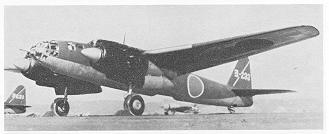![]() The Pacific War Online Encyclopedia
The Pacific War Online Encyclopedia
|
| Previous: P-66 Vanguard, U.S. Fighter | Table of Contents | Next: P2 Class, U.S. Transports |

Yokosuka P1Y1 Ginga (Milky Way) "Frances"
| Crew | 3 |
| Dimensions | 65'8" by 49'3" by 14'1" 50.80m by 15.01m by 4.29m |
| Wing area | 592 square feet 55.0 square meters |
| Weight | 16,017-23,149 lbs 7265-10,500 kg |
| Maximum speed | 340 mph at 19,355 feet 547 km/h at 5900 meters |
| Cruise speed | 230 mph at 13,125 feet 380 km/h at 4000 meters |
| Climb rate | 39 feet per second 11.9 meters per second |
| Service ceiling | 30,840 feet 9400 meters |
| Power plant | 2 1820 hp (1357 kW) Nakajima NK9B Homare 11 18-cylinder two-row radial engines driving three-blade propellers. |
| Armament | 1 20mm
Type 99 fixed nose cannon 1 20mm Type 99 flexible rear cannon |
| Bomb
load |
1 torpedo or up to
2200 lbs (1000 kg) of bombs plus two 58 gallon (220 liter) drop tanks |
| Range | 3340 miles 5370 km |
| Fuel |
1462 gallons (5535 liters) in
wing tanks |
| Production | Nakajima Hikoki
K.K., Koizumi: 6 prototypes (1943) 996 P1Y1 and P1Y1-S (1943-45) Kawanishi Kokuki K.K., Konan: 96 P1Y2 and P1Y2-S (1944-45) |
| Variants |
Various
versions
used engines with slightly different ratings and had modest changes in
the
armament. A number were equipped with a dorsal turret with twin 13mm Type 2 machine guns
in place of the tail cannon. The P1Y2 versions replaced the troublesome
Homare with a more reliable Kasei 25 engine. The most important variant was the P1Y1-S,
a night
fighter which
added four dorsal oblique-firing Type 99 20mm cannon. A small number of late production aircraft
carried Type
6 radar. |
"Frances" was the most modern bomber
built by the Japanese
Navy, entering service in 1944.
It was designed to fill the same role that the A-20 Havoc
and Beaufighter
did
for the Allies,
and it was able to outrun many Allied fightersat
low
altitude.
It was also highly maneuverable for a twin engine bomber, and one
Japanese veteran claimed the aicraft could even perform loops (Werneth
2008). However, relatively few were built and there were few skilled crews by
the time
these reached the front line.
"Frances" came out of a 1940 specification for a
fast medium bomber comparable with the American B-25 Mitchell and B-26 Marauder. The design team,
led by Mitsuzi Tadanao and Yamana Masao, produced a highly streamlined
aircraft with a narrow cross-section and mid-mounted wings. The engine
selected was the Homare, which was still under design at the time. The
wings were given very large fuel tanks, but only eight of fourteen
tanks were protected. Armor
was limited to a single plate behind the pilot's head and defensive
armament was also very limited. It was thought that speed would be the
aircraft's best defense against interception.
The prototype did not fly until the summer of
1943, but the Navy was so confident in the design that production of
the G3M "Nell" was shut down in February 1943 to retool the production
line for "Frances." 453 aircraft had already been produced when
the Navy formally accepted the type in October 1944. Unfortunately for
the Japanese, these aircraft asked too much of their maintenance crews,
and reliability suffered accordingly. As a result, the aircraft did not
see combat until early 1945. Those that did make it into the air
impressed their Allied
opponents with their performance.
The night fighter version proved disappointing due to inadequate high-altitude performance, and most were converted back to bombers or suicide aircraft.
References
The Pacific War Online Encyclopedia © 2007-2009, 2012 by Kent G. Budge. Index